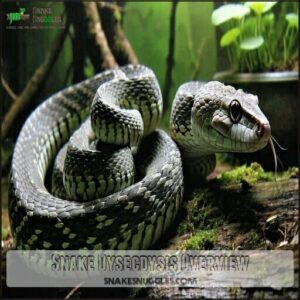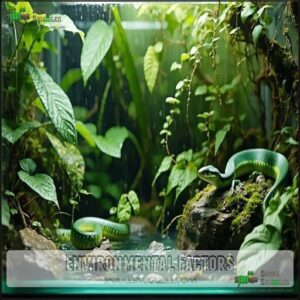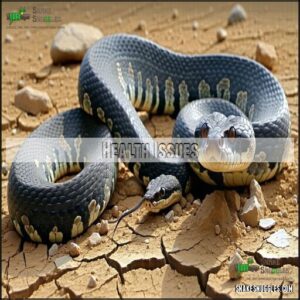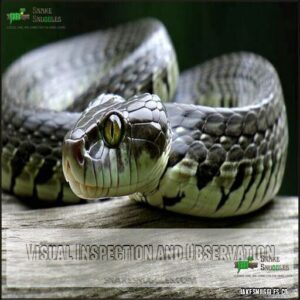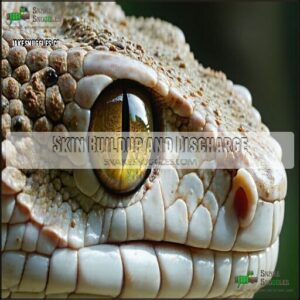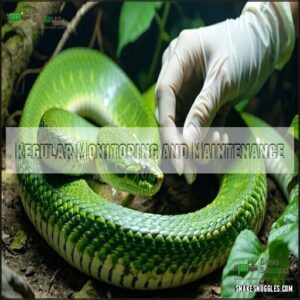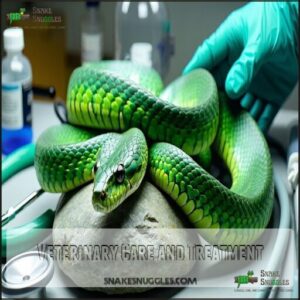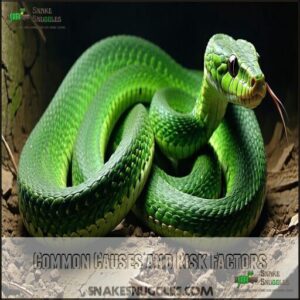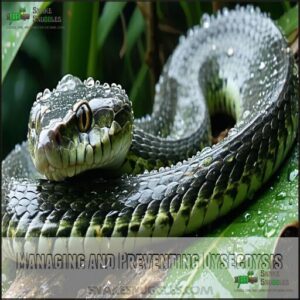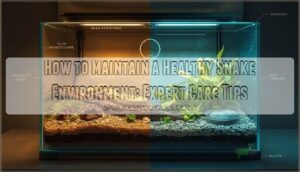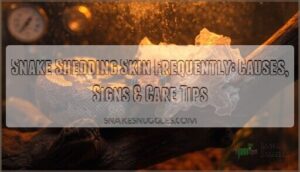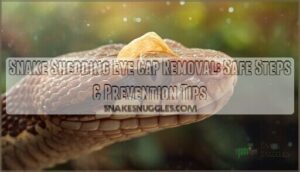This site is supported by our readers. We may earn a commission, at no cost to you, if you purchase through links.

Low humidity is the usual culprit, leaving their skin too dry to come off smoothly. If their tank feels a bit like the Sahara instead of a cozy rainforest, problems arise.
Poor nutrition, stress, skin injuries, or even mites can also play a big role. Sometimes, underlying health issues like infections or dehydration are to blame.
Think of it as your snake needing a good skincare routine—proper humidity, temperature, and attention make all the difference. Curious about fixing or preventing this? Stick around for key solutions to learn more about how to help your snake with trouble shedding.
Table Of Contents
- Key Takeaways
- Snake Dysecdysis Overview
- What Causes Snake Dysecdysis
- Environmental Factors
- Health Issues
- Shedding Process
- Dysecdysis Symptoms
- Reptile Care and Prevention
- Veterinary Care and Treatment
- Common Causes and Risk Factors
- Managing and Preventing Dysecdysis
- Frequently Asked Questions (FAQs)
- What is Dysecdysis in snakes?
- What does Dysecdysis mean in reptiles?
- How do you know if a snake has Dysecdysis?
- What causes Dysecdysis in lizards?
- Why is my snake shedding so hard?
- Which reptiles have Dysecdysis?
- How to prevent dysecdysis?
- What causes snakes to have diarrhea?
- What causes anorexia in snakes?
- How does stress directly affect snake shedding?
- Conclusion
Key Takeaways
- Keep your snake’s habitat humid and warm, as low humidity and poor temperature regulation are the main culprits behind shedding issues.
- Monitor their diet and hydration, since poor nutrition and dehydration make shedding difficult.
- Stress and poor hygiene in the enclosure can lead to dysecdysis, so provide a clean, comfortable environment and handle your snake gently.
- Watch for signs like retained skin or eye caps, as these signal underlying issues like infections, injuries, or parasites.
Snake Dysecdysis Overview
When your snake struggles to shed its skin properly, it’s a condition called dysecdysis, or abnormal shedding.
Abnormal shedding, or dysecdysis, signals underlying issues—help your snake shed smoothly with the right care and environment!
This isn’t just a bad “snake spa day” – it’s often a sign that something’s off with their environment or health.
Definition and Explanation
Snake dysecdysis, or abnormal shedding, happens when a reptile’s shedding process doesn’t go smoothly.
This isn’t just a cosmetic issue—it’s a sign something’s off. Healthy shedding, known as ecdysis, keeps their skin in top shape.
Common snake shedding problems stem from environmental mistakes or health concerns. Pinpointing dysecdysis causes quickly prevents worse shedding issues, like retained skin or complications.
Reptile Shedding Process
All reptiles, including snakes, need to shed their skin through a process called ecdysis. It’s all about growth and renewing those outer skin layers.
Shedding triggers include hormonal influence and environmental changes. Younger snakes shed more frequently due to rapid growth.
Problems like snake dysecdysis occur when the shedding process stalls, often revealing issues with scale formation and hydration.
Environmental Factors Affecting Shedding
Proper humidity and shedding go hand in hand—think of it like moisturizing your own skin.
Low humidity dries out scales, making shedding tougher.
Temperature gradients also matter; snakes need warm and cool spots to function properly.
Enclosure size, substrate choice, and lighting effects influence comfort and shedding success.
These environmental factors are common causes of dysecdysis, but they’re fixable, related to low humidity and improper temperature gradients.
What Causes Snake Dysecdysis
Snake dysecdysis happens when shedding doesn’t go smoothly, and it’s usually caused by issues like low humidity, poor nutrition, or even parasites.
When shedding goes awry, it’s a cry for help—low humidity, poor nutrition, or pesky parasites might be the culprits.
It’s like when you forget to moisturize—except your snake can’t grab a lotion bottle to fix it, which can be compared to a human forgetting to moisturize, emphasizing the importance of proper humidity.
Benefits Of Title Case
When understanding causes of dysecdysis, don’t underestimate Title Case.
It improves readability by creating a clear visual hierarchy, making your content look professional and organized.
Emphasizing key ideas like snake shedding difficulty or poor snake shed helps readers focus on important information.
Plus, it boosts brand consistency, giving your writing a polished, credible appearance—like a well-shed snake!
Environmental stress can lead to incomplete shedding and dysecdysis.
Examples Of Proper Usage
Think of a step-by-step guide: If your snake struggles with shedding due to poor husbandry or inadequate humidity, showing visual aids of ideal conditions can help.
Real-life scenarios, like a snake retaining skin because of nutritional deficiencies, highlight causes of dysecdysis.
Clear explanations—paired with interactive elements like humidity charts—make addressing snake dysecdysis straightforward and manageable.
Impact On Readability
Imagine reading about snake shedding problems with jumbled text and no breaks—it’s tough as shedding stuck skin! Good readability guides the eyes and brain.
Here’s how it helps:
- Font choices affect clarity; avoid fancy, unreadable styles.
- Whitespace usage prevents overwhelming blocks of text.
- Visual hierarchy organizes ideas smoothly.
- Simple text formatting highlights key points, enhancing clarity.
Environmental Factors
If your snake’s environment isn’t just right, shedding can quickly turn into a frustrating problem for both of you.
Low humidity, poor lighting, and dirty enclosures all mess with their natural shedding process, leaving them stuck with bits of dry skin.
Temperature and Humidity
Snake dysecdysis often stems from low humidity and poor temperature regulation.
Humidity levels should match your species’ needs, typically 50-70%.
Seasonal changes, like winter’s dry heat, can worsen shedding issues.
Use humidity gradients and a moist hide to help.
Maintaining proper humidity is vital, and you may need a reliable humidity reader to verify the correct levels.
Proper enclosure size allows better control of these factors, ensuring temperature and shedding stay on track for a healthy reptile.
Lighting and Hygiene
Good lighting and hygiene are key to healthy shedding.
UVB exposure supports skin health, while consistent lighting cycles reduce environmental stress.
Poor hygiene and waste buildup can lead to infections and dysecdysis.
Maintain enclosure sanitation by cleaning regularly, checking substrate cleanliness, and prioritizing waste removal.
Neglecting enclosure hygiene isn’t just bad husbandry—it puts your snake’s health at serious risk of infections, due to poor hygiene, and can lead to dysecdysis, which is exacerbated by environmental stress.
Nutritional Considerations
Meeting your snake’s nutritional needs is essential for avoiding dysecdysis. A poor diet or vitamin A deficiency can wreak havoc.
Confirm prey quality is of the highest standard and sized appropriately.
- Maintain hydration—dehydrated skin won’t shed properly.
- Avoid over-supplementation; too much of a good thing harms.
- Prioritize a balanced diet to prevent nutritional deficiencies.
Better feeding equals happier, healthier shedding!
Health Issues
When your snake struggles with shedding, underlying health problems like infections, parasites, or injuries might be to blame.
These issues can disrupt their normal shedding cycle, and spotting them early is key to keeping your scaly friend in top shape.
Infections and Parasites
Low enclosure hygiene invites skin mites and bacterial infections, which can lead to shedding troubles.
Internal parasites, like ascarids, worsen things by damaging organs. Fungal infections often thrive in unhygienic setups, creating stubborn skin buildups.
Septicemia risks arise when untreated infections spread. Regular cleaning, monitoring for parasites, and keeping enclosures healthy keep your snake safe and shedding smoothly.
Prevention beats battling infections, as it is crucial for maintaining a healthy environment, and regular cleaning is key to this, which in turn helps prevent septicemia risks.
Skin Trauma and Injuries
Sometimes shedding troubles stem from skin trauma.
Mishandling or abrasive surfaces can lead to lesions or infections.
Watch for:
- Bite wounds from live prey left unchecked.
- Thermal burns caused by direct heat sources.
- Enclosure hazards like sharp objects causing cuts.
- Abrasive objects wearing scales unevenly.
Gentle handling and safe enclosures help avoid these injuries and promote healthy shedding!
Nutritional Deficiencies
If skin trauma is one side of the coin, poor nutrition flips it.
A snake’s body can’t shed properly without a balanced diet.
Vitamin deficiency, mineral imbalance, or inadequate calcium supplements disrupt skin health.
Overfeeding mice but avoiding variety?
That’s like eating pizza daily—you’ll eventually regret it.
Guarantee hydration, diet variety, and proper nutritional support to avoid shedding headaches.
| Issue | Cause | Fix |
|---|---|---|
| Vitamin deficiency | Poor diet, imbalances | Balanced diet, supplements |
| Mineral imbalance | Inadequate prey nutrition | Calcium supplements |
| Dehydration impact | Lack of water intake | Maintain ideal hydration |
Shedding Process
When your snake sheds its skin, it’s part of a natural process that helps them grow and replace old scales.
If this cycle doesn’t go smoothly, it can lead to stuck skin, causing discomfort and potential health risks.
Normal Shedding Cycle
The normal snake shedding cycle, or ecdysis, happens as snakes outgrow their outer skin layers.
Shedding hormones trigger the lubrication process beneath old skin, easing scale renewal.
Ecdysis frequency depends on age, species, and health.
Think of it like your favorite hoodie getting snug—you trade it out.
With proper conditions, shedding abnormalities rarely occur, which is a key aspect of the snake’s health.
Abnormal Shedding Signs
If your snake’s shedding looks patchy or you see wrinkled, dull skin clinging to its body, that’s a sign of abnormal shedding.
Retained eyecaps, appetite loss, or lethargy often sneak in alongside incomplete shedding.
Snake dysecdysis, or "stuck shed," usually stems from poor humidity or health issues.
Spotting these early is key to keeping your pet healthy.
Proper shedding relies on adequate humidity levels to facilitate the snake sheds completely, which is crucial for preventing stuck shed.
Retained Skin and Eye Caps
When shedding goes wrong, retained skin and eye caps can cause big problems for snakes.
Those stubborn "stuck sheds" risk skin infection or even circulation cutoff. Never yank retained eye caps—use veterinary ointments or consult a vet.
Warm soaks help loosen incomplete shedding. Left untreated, complications could lead to amputation necessity.
Keep humidity ideal to avoid snake dysecdysis altogether.
Dysecdysis Symptoms
When your snake struggles with dysecdysis, you’ll spot dull, dry patches or pieces of old skin clinging stubbornly to its body.
Rubbing its face against surfaces or seeming more lethargic might also signal trouble—it’s like shedding gone all wrong!
Visual Inspection and Observation
It helps to keep an eye on your snake’s Skin Appearance and Eye Clarity.
During visual inspection, watch for incomplete sheds, cloudy scales, or peeling skin. Check for stuck eye caps—like someone wearing foggy glasses.
Monitoring shedding patterns and Body Condition regularly can spot abnormal shedding early.
Catching shedding issues quickly saves stress for you and your scaly friend!
Behavioral Changes and Lethargy
When reptile shedding goes awry, you might notice behavioral changes like hiding behavior or reduced movement.
Appetite loss and activity reduction are stress signs linked to snake dysecdysis. A common indicator is lethargy and anorexia in affected snakes.
Keep an eye out for these:
- Lethargy or lack of curiosity.
- Unusual irritability when handled.
- Extended periods in hide boxes.
- Skipping meals despite normal conditions.
- Obvious stress behaviors like rapid breathing.
Skin Buildup and Discharge
When dealing with snake dysecdysis, skin buildup around the eyes, tail, or belly is like wearing a stuck sweater—it feels restrictive.
You might notice discharge types like clear fluid or pus, signaling infection risk.
Scale accumulation from a stuck shed raises shedding complications and severity levels.
Address these signs early to prevent worsened infection or more serious causes of dysecdysis, and reduce the risk of infection.
Reptile Care and Prevention
Keeping your snake healthy starts with providing the right environment, including proper humidity, temperature, and nutrition.
Regular monitoring and a bit of effort go a long way in preventing shedding problems and keeping your reptile happy.
Proper Humidity and Temperature
Maintaining proper humidity and temperature is essential to avoiding environmental stress and dysecdysis.
Use these quick tips:
- Keep humidity levels species-specific (e.g., 50%-70% for most snakes).
- Create a temperature gradient for thermoregulation.
- Invest in monitoring tools like digital hygrometers.
- Make seasonal adjustments for natural cycles.
- Watch for low or inadequate humidity signs like dull, dry skin.
Simple tweaks make happy, healthy snakes! Consistent moisture can be achieved with reptile misting systems, which helps in maintaining proper humidity and ensuring healthy snakes.
Regular Monitoring and Maintenance
Tracking the shedding cycle keeps you ahead of snake shedding problems.
Regular monitoring guarantees early intervention for symptoms like retained skin.
Maintain enclosure cleanliness with spot-cleaning and substrate changes.
Preventative healthcare, like addressing snake husbandry issues, minimizes the causes of dysecdysis. Stay consistent with supplement schedules and observe behavior often.
A little attention prevents big snake enclosure headaches, ensuring a healthy environment through regular monitoring and preventative healthcare.
Dietary Considerations and Supplements
To prevent dysecdysis, focus on a balanced diet and hydration.
Nutritional support is key—consider prey gut-loading or vet-approved oral supplements.
Verify that calcium intake meets your snake’s needs and avoid overloading Vitamin A.
A well-fed snake sheds easier, so feed smaller, softer meals during shedding.
See snake calcium supplements for dietary support.
Remember: their diet’s as important as your morning coffee (but less complicated!).
- Tips for dietary success:
- Gut-load feeder prey for added nutrients.
- Offer a vet-approved diet for long-term health.
- Hydration importance: make certain constant water access.
- Prioritize calcium intake with correct phosphorus balance.
- Monitor for signs of malnutrition or shedding issues.
Veterinary Care and Treatment
When your snake’s shedding issues don’t improve with home care, it’s time to bring in the professionals.
A vet can address underlying health problems, prescribe treatments, and even safely remove stuck skin if needed.
Severe Symptoms and Complications
Your snake’s severe symptoms, like vision impairment or skin infections, might signal serious complications.
Retained skin can cause tissue necrosis, eye damage, or respiratory problems.
Left unchecked, issues like secondary infections or septicemia could lead to organ damage or even amputation risks.
Don’t take chances—your scaly friend’s health depends on swift action and attention to these critical warning signs.
Medications and Surgical Removal
When dysecdysis gets complicated, medications and surgical steps might step in.
Antibiotic options and antiseptic applications, like povidone-iodine, tackle infections. A veterinarian may suggest ivermectin for parasites.
Surgical necessity arises with severe tissue necrosis, amputation being a last resort. Post-op care, including pain management and monitoring, guarantees smooth recovery.
Remember, snakes deserve "scalely" healthcare too!
- Antibiotics: Treat infections promptly.
- Medications like ivermectin: Handle parasites effectively.
- Surgical removal: Address retained skin causing necrosis.
- Post-op care: Pain relief and recovery are priorities.
Emergency Situations and Consultations
When you notice urgent symptoms like severe skin buildup, swelling, or retained eye caps, don’t wait—seek veterinary care immediately.
A quick examination and diagnosis can prevent complications. Sometimes, treatment involves surgical options or complication management for infections.
Post-op care, including hydration and proper humidity, guarantees recovery. Remember, professional intervention is always better than guessing.
Your snake’s health depends on it!
Common Causes and Risk Factors
When your snake struggles with shedding, it’s often linked to its living conditions or overall health.
Factors like low humidity, poor diet, or even stress can make shedding a real challenge for them.
Poor Husbandry Practices
When enclosures are too small or lack proper hiding places, snakes feel stressed.
Low humidity and poor substrate choices worsen shedding issues, while inadequate water availability leads to dehydration.
Handling them too often only adds to their anxiety.
These poor husbandry practices, like neglecting enclosure size or ignoring signs of stress, are common causes of dysecdysis, making shedding a frustrating struggle.
Genetic Predisposition and Age
Some snakes face shedding problems because of genetic predispositions and age.
Inherited traits or genetic defects can influence skin growth.
Young snakes may struggle during growth spurts, while senior snakes encounter skin elasticity issues.
Here’s what to keep in mind:
- Juvenile shedding happens more frequently, needing extra care.
- Genetic predispositions might exacerbate dysecdysis.
- Age-related changes slow shedding processes.
Environmental Stress and Trauma
Stress from poor husbandry, like handling trauma or inadequate humidity, can worsen shedding.
Temperature extremes or lighting stressors confuse their biological rhythms, while abrasive surfaces, or the lack of them, hurt skin shedding.
| Environmental Factors | Impact on Shedding | Solution |
|---|---|---|
| Temperature Extremes | Disrupts shedding cycle | Use thermostats |
| Poor Enclosure Hygiene | Causes infections | Clean regularly |
| Abrasive Surfaces | Skin trauma or buildup | Provide smooth branches |
The key factors to consider are poor husbandry, temperature extremes, abrasive surfaces, and maintaining proper humidity to prevent shedding issues.
Managing and Preventing Dysecdysis
Don’t worry—managing and preventing dysecdysis is simpler than it sounds when you focus on your snake’s basic needs.
Keep the humidity just right, provide comfortable shedding tools, and your scaly friend will thank you with a smooth shed every time!
Humidity Chambers and Soaking
If your snake struggles with low humidity, a humidity chamber can work wonders.
Use moisture-retentive chamber materials like damp moss, ensuring a stable temperature gradient.
Pair that with soaking in warm water for 10–30 minutes to soften stubborn skin.
You can even purchase a pre-made reptile enclosure for convenience.
For species variation, adjust the soaking duration. Some cases might need medication addition, but most thrive in a humid environment with proper care, including the use of a pre-made reptile enclosure.
Gentle Removal of Retained Skin
Gently removing retained skin from a stuck shed snake can be tricky, but a warm water soak softens the skin first.
Use safe tools, like your fingers or a damp cloth, to avoid damage. Ointment application helps ease stubborn areas.
If manual removal fails, don’t hesitate to seek professional help—health is always more important than at-home removal methods.
Regular Check-ups and Veterinary Consultations
Regular check-ups with a reptile vet can save you headaches—and your snake’s skin.
Preventative care helps spot subtle symptoms early, like dull scales or unusual behavior.
Specialist reptile vets provide expert guidance for diagnosis and treatment plans.
While veterinary care costs aren’t pocket change, it’s cheaper than fixing major issues later, which is why you should prioritize examination frequency to keep shedding stress-free.
Frequently Asked Questions (FAQs)
What is Dysecdysis in snakes?
Dysecdysis is when a snake has trouble shedding its skin properly.
It’s not a disease but a symptom of issues like low humidity, poor nutrition, or stress.
Think of it as a skin-care warning!
What does Dysecdysis mean in reptiles?
It’s like a wardrobe malfunction for reptiles—dysecdysis means they’re struggling to shed old skin properly.
This signals underlying issues like low humidity, poor nutrition, or health problems needing your keen observation and care.
How do you know if a snake has Dysecdysis?
You’ll notice patchy, flaky skin, clouded eyes, or pieces of old skin stuck on the snake’s body.
If it looks like your snake is wearing last year’s outfit, it’s likely struggling with dysecdysis.
What causes Dysecdysis in lizards?
Too much stress, low humidity, poor lighting, or a lack of proper diet can trip up your lizard’s shedding game.
Add parasites or skin injury to the mix, and shedding turns into a messy ordeal.
Why is my snake shedding so hard?
Your snake may struggle with shedding due to low humidity, poor nutrition, or inadequate enclosure setup.
Check the environment’s humidity, offer a rough surface for rubbing, and provide a warm soak to help loosen skin, which can be a crucial step to aid with shedding.
Which reptiles have Dysecdysis?
Ever wondered if all reptiles struggle with skin issues?
Dysecdysis affects various species, from snakes and lizards to geckos and turtles.
Any reptile can face shedding troubles, especially with poor humidity, nutrition, or care!
How to prevent dysecdysis?
To prevent dysecdysis, keep the habitat warm and humid, provide rough surfaces for shedding, and make certain a nutritious diet.
Think of it like running a reptile spa—comfort, hydration, and a good meal are key!
What causes snakes to have diarrhea?
Have you ever considered poor diet or unclean habitats triggering diarrhea in snakes?
Parasites, bacterial infections, or temperature stress often disrupt digestion.
Keep their environment clean and diet consistent to keep their gut happy and avoid issues like diarrhea.
What causes anorexia in snakes?
Anorexia in snakes often stems from stress, incorrect temperatures, illness, or improper diet.
Sometimes they’re just picky eaters or fasting before shedding.
Fix their setup, guarantee health, and they’ll likely start munching again to resolve the issue of anorexia.
How does stress directly affect snake shedding?
Stress messes with your snake’s hormones, throwing their shedding process off track.
It weakens their immune system, stalling skin renewal.
Imagine wearing a tight sweater you can’t take off—unresolved stress keeps them stuck, literally, and this is due to stress.
Conclusion
In regards to snake care, don’t let trouble shedding become the “thorn in your side.”
Snake dysecdysis often stems from environmental issues like low humidity or poor nutrition, but with proper adjustments, you can tackle it head-on.
Guarantee your snake’s habitat mimics their natural needs—maintain ideal humidity, temperature, and cleanliness.
Regular monitoring, diet improvements, and veterinary checkups can work wonders.
By addressing what causes snake dysecdysis, you’ll help your snake shed effortlessly and stay healthy.

